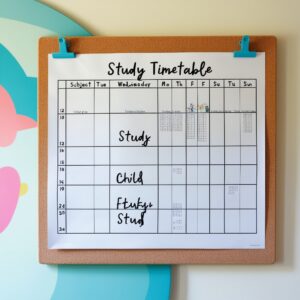It is a well-known fact that a nice educational surrounding is very important for the support of children’s academic success and emotional growth. Nonetheless, the fact that a lot of children are participating in remote learning or hybrid models makes it more necessary to bring about a home-based learning space that is not only of high quality but is also powerfully engaging for the child. The right learning space, with the right vibe, will be a game-changer in how a child can concentrate, store information, and have a good mood while studying.
This piece aims to give practical ideas on how to set up a positive learning environment at home to guarantee academic success and excellent psychological well-being. Besides creating the right space, we will acquaint you with even more ways of making your home a positive environment where learning is a pleasure.
Why Positive Learning Environment is of Great Importance
The children’s learning environment has a great bearing on their success in school. Numerous studies found that students are more likely to make progress in their studies if they not only are safe and comfortable but also have a high level of engagement in the learning process. This is not just about having a clean and tidy room or a well-organized desk—this is about creating an environment that stimulates the child’s creativity, curiosity, and self-confidence. The child who is given help and is made to feel valuable is the one who will be the most successful not only academically but also emotionally.
It’s not the case that just the room, or the physical space, is the only thing that needs to be worked upon; it is the combination of characteristics, which include, among others, appropriateness and flexibility, the children’s autonomy, and the appropriate level of adults’ assistance. These are the items we are going to discuss, and irrespective of whether you are willing to do a complete study area in your house or take a corner of your living room to create useful joint learning spaces, the next list is going to illuminate a balanced, effective environment to you.
1. Design a Comfortable and Organized Study Space
The initial phase of the actualization of a productive learning environment in your house is to come up with a room that is not only comfortable but also is organized. A messy or disarranged place can result in both distractions and stress, whereas an adequately arranged study space can be very effective in helping students concentrate and be productive.

Key Tips:
- Selecting the Right Location: It would be best if it were a calm area without much movement around. If the space is not enough, the idea of allocating a certain place within the shared space should be considered.
- Pillars of Comfort: Along with a chair you can sit in without getting a backache and a lamp that provides good light, a desk to sit at that is made in the right way is the necessary thing for your physical health improving process.
- Utility Supplies: First of all, you should have the learning supplies at hand-using pens, paper, notebooks, calendar for noting deadlines. Secondly, kids can only study when there are no unnecessary noise and interruptions.
2. Establish a Routine with Flexibility
Organization is crucial, but so is the ability to be open to change. To avoid boredom and always having something new to look forward to, the children should be guided in. formation of habits that will help to anchor them.

Key Tips:
- Set Up a Plan: A planner or wall timetable is a must-have for kids as it will encourage them to be responsible and do the tasks by themselves. Don’t forget to include short rest periods and fun activities such as physical exercises and creative activities to prevent children from getting too tired psychologically and emotionally.
- Give Space for Leisure: Regular and scheduled quick intervals for a walk-empty fluids and take a breath, fleetly enable a shift in the way that the brain operates and a tremendous improvement to occur in the effort of concentration without really feeling the strain. One practical technique in doing this is the Pomodoro—one’s work time is for 25 minutes and it is followed by a 5-minute rest.
- Being Flexible: It is important to keep a level of consistency but the possibility of being flexible should not be ruled out. At times, the child may want to spend more time on a certain subject or take a longer break. In that case, rescheduling will be necessary to maintain a proper work-rest ratio.
3. Foster a Growth Mindset
A growth mindset is one of the best presents you can give to your little one. If children are convinced that they can become smarter through perseverance and learning, they are more likely to take on challenges, be resilient in the face of difficulties, and in the end, achieve success.

Key Tips:
- Praise Effort, Not Just Results: Concentrate on the effort your child devotes to the project instead of just congratulating him/her on their grades or results. This way, they will start seeing faults as a learning process rather than as something being unsuccessful.
- Encourage Problem-Solving: Refrain from giving direct answers and instead, ask your child questions that will lead him/her to the answers themselves. Such actions foster creative thinking and persistence.
- Celebrate Achievements: Give a small nod of the head to even the smallest of steps. This reiterates the association between work and result, hence, it becomes a source of inspiration for your child’s continued pushing forward.
4. Create Emotional Support and Encouragement
Your children’s emotional well-being is as important as their academic success. A favourable learning environment is not just about the physical arrangement; it is also about a place where children feel themselves emotionally supported and encouraged.

Key Tips:
- Be Honest in Your Communication: Keep the communication channels open between you and your child. Share and talk about the things that your children are struggling with, the sad or happy moments they are experiencing. This way, not only does the emotional bond between you and your children become stronger, but also it will be easier for them to show how they feel.
- Encourage Self-Expression: It will be great if you let your child say what he or she likes and give an opinion about the learning process he or she is facing. It will lead to a lot of them feeling like they’re involved, more in control of their academic success.
- Provide Motivation and Reassurance: Convince your child that making mistakes is not the end of the world, and it is natural. By this, you can make the point that every mistake is an occasion to become wiser and more developed.
5. Minimize Distractions
Studying at home can be a source of interruption for many kids from noisy siblings to the lure of gadgets. To remove such distractions is a must to keep the child’s focus on learning.

Main Ideas:
- Computer Time Less: You can use special apps and parent control. This will help your child not to get involved in any social media activities or gaming, during the study time. Thus, he/she will be more efficient in the work.
- The “No Distraction” Zones: If it is possible, make separate places for learning and playing. This allows the kid to be able to concentrate more just after entering the study area.
- Musical Utilization: Your child may work while some background music is on, but others work in silence. To find out which type of music is the most beneficial, you can give different types of music or radio silence a try.
6. Incorporate Fun Learning Activities
Acquiring knowledge through the process of learning is not just limited to the information coming from school books or online videos but can be a pleasurable experience through fun activities. This keeps children interested in school subjects and at the same time reinforces the main principles.
Main Ideas:
- Hand-on Learning: Use hands-on activities such as science experiments, drawing, or cooking projects to illustrate concepts. Involving different kinds of senses and making learning into a game are the main characteristics of such activities.
- Technological Methods: Educational apps and websites are a good tool to improve the interaction and excitement of learning. These methods are to be used in addition to the traditional ones.
- Some people might have their children: Besides, supporting the reading habit, they can also be engaged in painting and drawing or playing the piano or the guitar. This will help children’s overall development and make them become even more curious.
Building the perfect learning ground at home is not a single event with a start and a finish that talks about intent, patience, and flexibility. By making a physical space where children can concentrate, elevating the mental health of kids, and nurturing a growth mindset, you can partner with your child and see that they are already winning in their school life irrespective of the environment that they are in for their studies.



